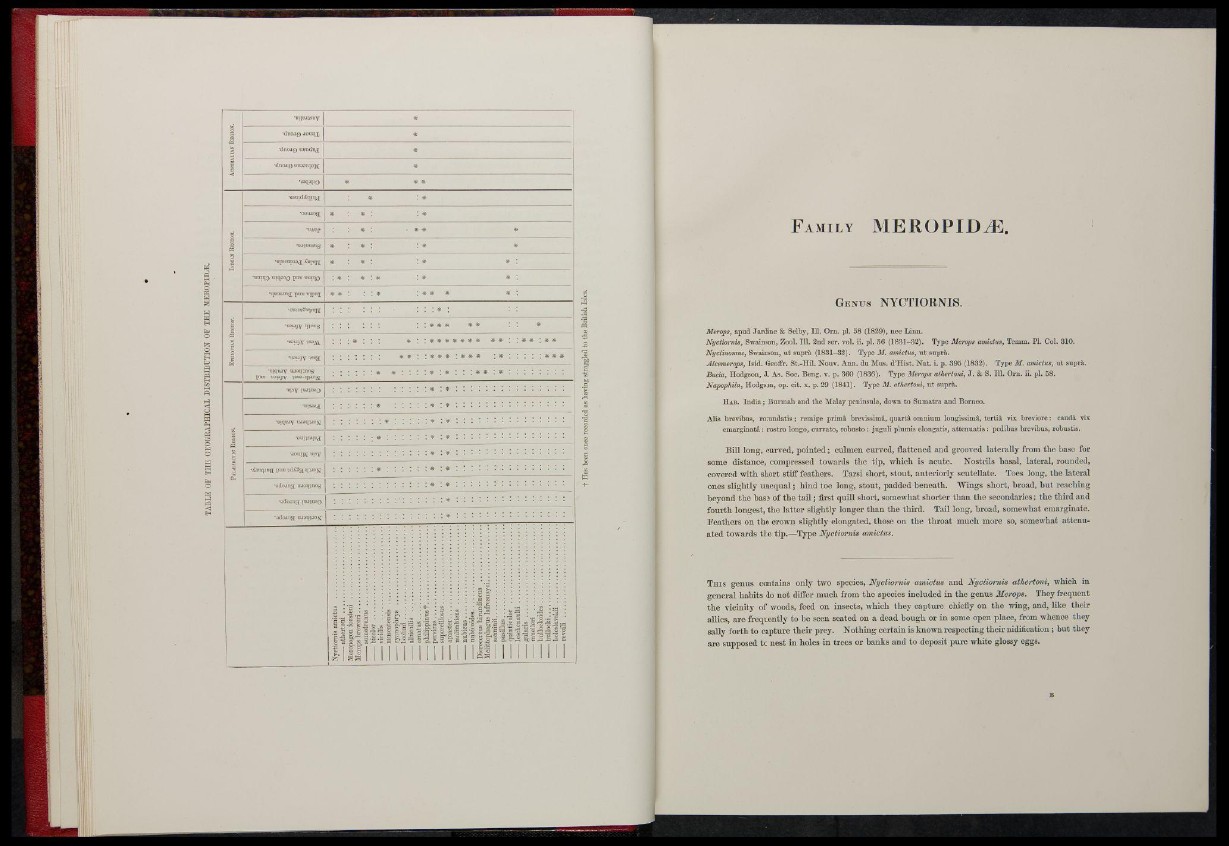
1
1
•«!lnJls"V *
•<Iiio.lrj JOUIIX *
•ciiiuji) iwnclvj * »
1
•eoniddrrqa * : *
»
™r • : • * * *
* * ' * *
•rc[i!Btni[,i,| * *
•unit|ki PppOQ pun miiijQ : * : * • * * #
•qBinjufl pun KIJULJ » *
1
•nORjy q-jnog » * * » * •
* *
•uaujy isng
uiqtuy oiaqiiiog
* * : :
pas Ti.ii.yy IBWMfHOR i
1
. : . : : : : : : :
•~« * : : :
-siqnjy amqwil : . : : . : . : : : : : : :
* : : * : * : : : : : : :
* : * : : : : " : :
•jtroqinji pun idiifa TVS • : : : : * : * : : : : : : :
•ailojng pujtiso
•edojng M»q>JO]J : . : : : : : : :
i
s e
! B
I
i' Ifii
mi
fj g"i
T
i i
i i l s .
| | | | I I I '
'mill "
i i s f l i 1
llllll
F a m i l y M E R O P I D ^.
Genus NYCTIORNIS.
Merops, apud Jardinc & Selby, III. Orn. pi. 58 (1829), nec Liiin.
Kyctiornis, Swainson, Zool. 111. 2nd ser. vol. ii. pi. 5G (1831-32). Type Merops amictus, Temm. PI. Col. 310.
N'jctiiimiuis, Swainson, ut suprii (18151-32). Type 3/. amictus, lit supra..
Atcemerops, Isid. Gcofir. St.-Ilil. Nouv. Ann. du Mus. d'Hist. Xat. i. p. 3 9 5 (1832). Type M. amictus, ut supra.
Bueia, Hodgson, J. As. Soc. Beng. v. p. 360 (1836). Type Merops at/iertotti, J. & S. 111. Orn. ii. pi. 68.
Napophila, Hodgson, op. cit. s . p. 29 (1811). Type .If. athertoni, ut supra.
HAD. India; Burmak and tlic Malay peninsula, doivn to Sumatra and Borneo.
Alis brevibus, rotuudatis; rcmige prima brcvissinia, quarta oiiiiiiuiii lougissiniil, tcrtia vix breviore: caudfi, vix
emargiuata: rostro longo, curvato, robusto : juguli plumis clongatis, attcuuatis : pedibus brevibus, robustis.
Bill long, curved, pointed; culmen curved, flattened and grooved laterally from the base for
some distance, compressed towards the tip, which is acute. Nostrils basal, lateral, rounded,
covered with short stiif feathers. Tarsi short, stout, anteriorly scutellate. Toes long, the lateral
ones slightly unequal; hind toe long, stout, padded beneath. "Wings short, broad, hut reaching
beyond the base of the tail; first quill short, somewhat shorter than the secondaries; the third and
fourth longest, the latter slightly longer than the third. Tail long, broad, somewhat emarginate.
Feathers on the crown slightly elongated, those on the throat much more so, somewhat attenuated
towards the tip.—Type Nyctiornis amictus.
THIS genus contains only two species, Nyctiornis amictus and Nyctiornis athertoni, which in
general habits do not differ much from the species included in the genus Merops. They frequent
the vicinity of woods, feed on insects, which they capture chiefly on the wing, and, like their
allies, are frequently to be seen seated on a dead hough or in some open place, from whence they
sally forth to capture their prey. Nothing certain is known respecting their nidification ; but they
are supposed to nest in holes in trees or banks and to deposit pure white glossy eggs.